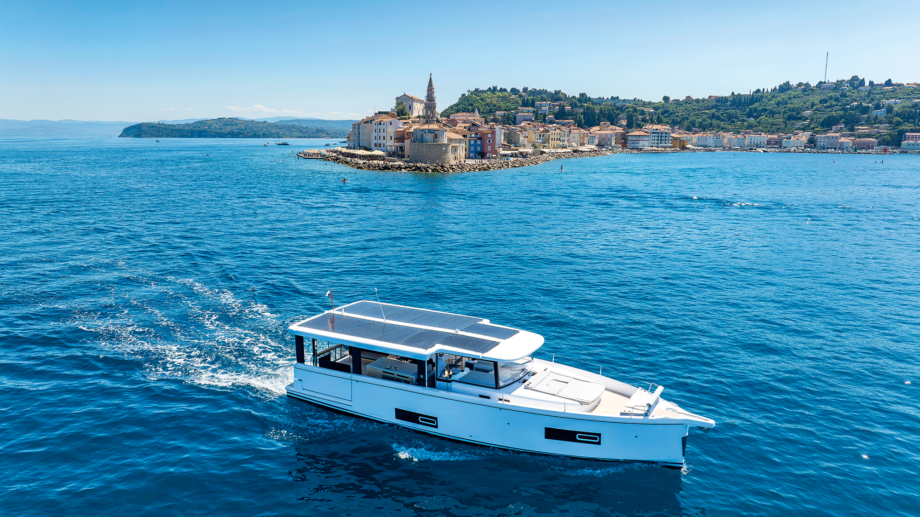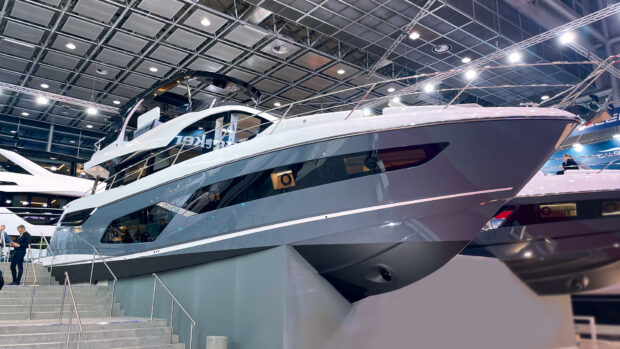With its radical ‘monomaran’ hull, hybrid drive, and vast outdoor lounge, is Beneteau’s new boat, the Beneteau Island Cruising Concept, the shape of things to come? Hugo Andreae investigates.
Tucked away in a quiet corner of the Düsseldorf boat show was one of the most interesting concept crafts of recent years. If that sounds like a bold claim for something that, on the face of it, looks rather uninspiring, stick with us, as its sober styling hides some genuinely revolutionary ideas, including a radical ‘monomaran’ hull, a super-efficient solar assisted drivetrain and a game-changing new layout.
Called the Beneteau Island Cruising Concept, it deliberately ignores the usual motor boat design tropes in favour of a fresh approach based on how people actually use their boats. Most of the time, that isn’t racing around at high speed or cruising for days on end, it’s a gentle potter to a nearby island for several hours of chilling with friends and family before pottering on to the next one, then rinse and repeat – hence the Beneteau Island Cruising name.

Electric drives give 2.5 hours silent cruising and up to 250nm with the generator running
In fact, according to data collected from Beneteau’s Seanapps boat monitoring app, most boat owners spend 80% of their time at anchor, eating, drinking and socialising.
So rather than prioritising strong performance, sporty looks and maximum interior space, Beneteau has done the opposite and put the emphasis on relaxed, sociable outdoor living. The result may not be particularly pretty but there’s no doubting the benefits it brings.

Space is limited but they all have basic ensuite bathrooms
Beneteau Island Cruising Concept: A room with a view
First and foremost is a simply enormous outdoor lounge. In any other boat we would refer to it as an aft cockpit but with its folding balconies, 360-degree views, roll-up canopies and freestanding furniture, it feels more like a pool house or beachside cabana than a cramped cockpit.
The centrepiece of this is a large outdoor galley. Much like an island kitchen in an open-plan apartment, this isn’t just a place to prepare food or wash the dishes, it’s also a focal point for social gatherings where you can grab a drink, chat to the chef and join in the action.

Folding platforms extend the size of its indoor/outdoor lounge, galley and dining area
Immediately opposite is an equally sociable dining table large enough for eight people to enjoy an al fresco meal, while further aft are a pair of patio-style sofas which lock into place underway but can be relocated to the folding balconies to make the most of the views at anchor.
The helm, by comparison, feels something of an afterthought with its large-diameter wheel and rather basic dashboard but at least it’s open to and on the same level as the lounge so you don’t feel cut off from the action.
This whole area is covered by a hardtop with a mix of glazed panels and roll-up clear PVC canopies that provides shade from the sun and shelter from the elements but opens up like a beachside bar when conditions allow.

From the stern you can clearly see it has two hulls just like a conventional powercat
What we hadn’t realised until we saw it in Düsseldorf is that far from being a glorified dayboat, it also has four double cabins below deck, each with its own ensuite. The cabins are quite pokey and the heads are wet rooms with pull-out shower hoses but for family use or charter holidays that’s all that’s really needed.
Article continues below…

Beneteau Swift Trawler 54 review: £1.4M cruiser is the ultimate home

Beneteau Antares 12 review: The boat to beat the Merry Fisher flagship?
Monomaran hull
However, it’s the technical side where things start to get really interesting. The hull shape is unlike anything we’ve seen before. Viewed from the front it looks like a beamy sailing boat minus the mast, right down to the slender vertical stem, bowsprit anchor platform and round bilge underwater bow section.
But when viewed from astern, it’s clear there are two separate hulls linked by a bridge deck above the waterline, just like a catamaran.

From the bow it looks like a monohull sailing yacht that’s missing its mast
It’s only when you crawl underneath that you can see these two hulls merging into one about 15ft from the bow, so what looks like a full-length tunnel is actually a giant U-shaped scoop that gets wider and taller the closer it gets to the stern.
The theory of this so-called ‘monomaran’ hull design is that it delivers the low draft, stability and cruising efficiency of a catamaran (ideal for comfortable cruising and anchoring in shallow bays) with the seakindly manners and dimensions of a monohull (for easier handling and lower berthing fees).

The two hulls merge into one near the bow
The drivetrain is just as innovative but crucially it’s all based on existing off-the-shelf Fischer Panda products rather than expensive and often unreliable custom-built equipment. The heart of the system is a pair of compact electric saildrives. Packing just 11kW each (around 15hp), they won’t set the world on fire but should give a comfortable cruising speed of 7-8 knots.

The helm is fairly basic by motor yacht standards
These simple fixed pods are mounted outside the hull, meaning there is no need for a separate cooling system, while the steering is taken care of by a pair of big rudders. With so little to go wrong, it should make for an extremely quiet, reliable and easy to maintain driveline.

Freestanding furniture and an island galley give the feel of a beachside cabana or pool house
Solar flare
Powering these electric motors are eight 5.8kWh lithium ion batteries. Their combined 46.4 kWh should give at least 2.5 hours of cruising on battery power alone but that’s before you take into account the boost from the 4kWp of solar cells embedded in the hardtop.

Solar panels generate up to 4kW of power
Together that should be enough for a typical day’s island hopping but if the weather turns or you want to cruise further afield you can always fire up the 22kW diesel generator and extend the range to 250nm. And for those who still don’t like the idea of relying on hybrid power, there’s always the option to spec it with a pair of regular shaftdrive diesel engines instead.

All four guest cabins are squeezed into the forward part of the hull
 If you enjoyed this….
If you enjoyed this….
Motor Boat & Yachting is the world’s leading magazine for Motoryacht enthusiasts. Every month we have inspirational adventures and practical features to help you realise your sailing dreams, as well as tests and news of all the latest motorboats.
Plus you’ll get our quarterly Custom Yachting supplement where we share the last on offer in the superyacht world and at the luxury end of the market.
Build your knowledge with a subscription delivered to your door. See our latest offers and save at least 30% off the cover price.
Verdict
When we first saw the renderings of Beneteau’s new concept boat, it’s fair to say we were a little underwhelmed – concept craft are usually design-led whims that look fabulous but are hopelessly impractical. This is the exact opposite but having now crawled all over it, we can see where Beneteau is coming from. We still need to test how well that monomoran hull works, especially in lively sea conditions, and we still think the aesthetics need a bit of work to convince people to part with their cash but if Beneteau can turn this promising concept into a genuinely desirable production boat, while keeping the price below the anticipated €500,000 mark, it might just have stumbled on a bright new future.
Details
LOA: 46ft 3in (14.10m)
Beam: 14ft 9in (4.50m)
Draft: 2ft 9in (0.85m)
Engines: 2 x 11kW Fischer Panda saildrives
Top speed: 8 knots
Range: 250nm
Batteries: 8 x 5.8kWh
Generator: 22kW
Fuel: 200 litres
Price: From €495,000 (TBC)



 If you enjoyed this….
If you enjoyed this….





